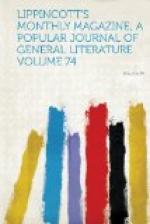in no wise stinted in the quantity of material, they
are wonderfully strong and enduring. The most
remarkable thing about them, however, is the unerring
instinct with which these uneducated manufacturers
harmonize the most audaciously violent contrasts of
brilliant color. It is not too much to assert
that they are
never at fault in this respect.
So much is this the case, and so truly artistic is
this homely peasant manufacture, that there is hardly
a painter’s studio in Rome in which two or three
of these richly colored apron-cloths may not be seen
covering a sofa or thrown over the back of a chair.
A great part of the singularly picturesque and striking
appearance of the group of figures we are speaking
of is due to the universal use of these aprons by
the women. The men also affect an unusually large
amount of bright color in their costume. The waistcoat
is almost always scarlet; the velveteen jacket or short
coat generally blue; the breeches sometimes the same,
but often of bright yellow leather, and the stockings
a lighter blue. The men often wear a long cloak
reaching to the heels, always hanging open in front,
and generally lined with bright green baize.
They generally, too, have some bright-colored ribbons
around their high-peaked, conical felt hats. But
I must not forget to mention the costume of the children.
It consists of an exact copy in miniature of that
of their elders; and the inconceivable quaintness
and queer old-world look produced is not to be imagined
by those who have never witnessed it. Fancy a
little imp of six or seven years old dressed in little
blue jacket, bright-yellow leather breeches, blue
stockings, sheepskin sandals on his little bits of
feet, and long bright flaxen curls streaming down
from under a gayly-ribboned brigand’s hat!
But if the first glance is given to this singularity
of costume, the second will not fail to take cognizance
of the remarkable beauty of feature to be observed
in almost every individual of this race of models.
The men are well grown, almost invariably wear their
black hair streaming over their shoulders, and have
generally fine eyes and picturesquely colored, swarthy
red faces. But the beauty of the girls is in
almost every case something quite extraordinary; and
the same may be said of the children. The next
thing which the closeness of observation this unusual
degree of beauty is calculated to attract will reveal
to the observer is that all these singularly lovely
faces are remarkably like each other, and at the same
time remarkably unlike any of the faces around them.
There is often much beauty among the Roman women of
the lower classes, but it is of an essentially different
type. The Roman beauty is generally large in
stature and ample in development, with features whose
tendency to heaviness needs the majestic and Juno-like
style of beauty which the Roman women so frequently
have to redeem them. But the countenances of
the women of whom we have been speaking have nothing




